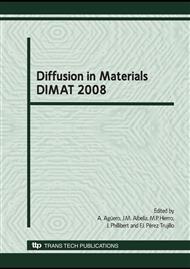p.615
p.623
p.633
p.641
p.649
p.657
p.665
p.673
p.679
Formation of a Nano-Hole via Oxidation of Metal Nanoparticles
Abstract:
The formation of hollow metal oxide nanoparticles through oxidation process has been studied by transmission electron microscopy for Cu, Zn, Al, Pb and Ni in order to clarify the detailed formation mechanism of hollow oxide nanoparticles and their governing factors. For Cu, Zn, Al and Ni nanoparticles, hollow oxide nanoparticles are obtained as a result of vacancy aggregation in the oxidation processes. These results arise from faster outward diffusion of metal ions through the oxide layer in the oxidation processes. On the other hand, Pb nanoparticles turn to solid PbO, because the diffusivity difference DPb < DO in PbO leads to no formation of vacancy clusters.
Info:
Periodical:
Pages:
649-656
Citation:
Online since:
April 2009
Authors:
Keywords:
Price:
Сopyright:
© 2009 Trans Tech Publications Ltd. All Rights Reserved
Share:
Citation:


